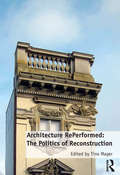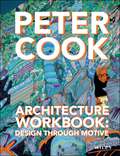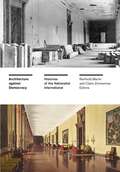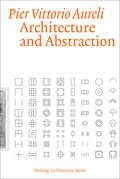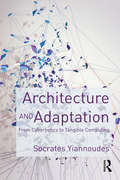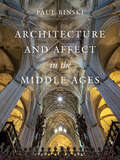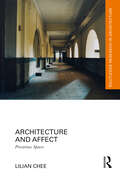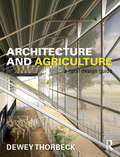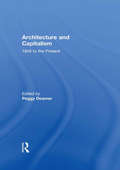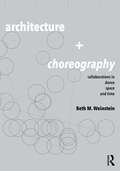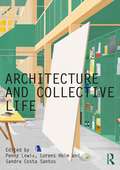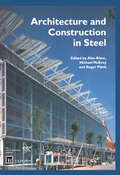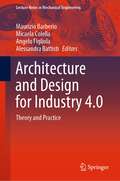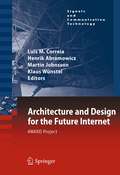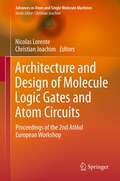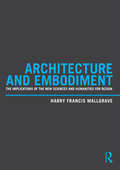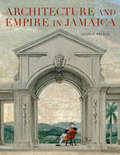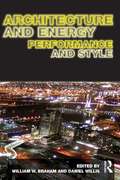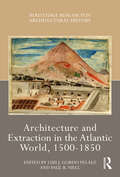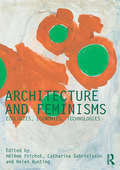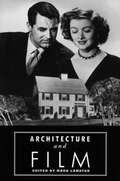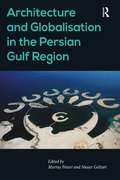- Table View
- List View
Architecture RePerformed: The Politics Of Reconstruction
by Tino MagerFirst emerging at the beginning of the twentieth century, architectural reconstruction has increasingly become an instrument to visually revive a long bygone past. This book deals with the phenomenon of meticulous reconstruction in architecture. It argues that the politics of reconstruction go far beyond aesthetic considerations. Taking architecture as a major source of history and regional identity, the impact of large-scale reconstruction is deeply intertwined with political and social factors. Furthermore, memories and associations correlated with lost buildings of a bygone era are heavily influenced by their re-appearance, something which often contradicts historical events. Reconstruction has become an established way of building and dealing with the past, yet so far, there is no comprehensive scientific study on it. By bringing together eight case studies from Eastern Europe, France, Spain, China, Japan, Israel and Brazil, it provides valuable insights into this topic. The chapters analyse the political background of the reconstructions and identify the protagonists. In doing so, this volume adds to our understanding of the impact of reconstruction to memory and oblivion, as well as the critical power of reconstruction regarding contemporary architecture and urbanism.
Architecture Workbook: Design through Motive
by Peter CookOrganised into 9 parts that highlight a wide range of architectural motives, such as 'Architecture as Theatre', 'Stretching the Vocabulary' and 'The City of Large and Small', the workbook provides inspiring key themes for readers to take their cue from when initiating a design. Motives cover a wide-range of work that epitomise the theme. These include historical and Modernist examples, things observed in the street, work by current innovative architects and from Cook's own rich archive, weaving together a rich and vibrant visual scrapbook of the everyday and the architectural, and past and present.
Architecture against Democracy: Histories of the Nationalist International
by Claire Zimmerman Reinhold MartinExamining architecture&’s foundational role in the repression of democracy Reinhold Martin and Claire Zimmerman bring together essays from an array of scholars exploring the troubled relationship between architecture and antidemocratic politics. Comprising detailed case studies throughout the world spanning from the early nineteenth century to the present, Architecture against Democracy analyzes crucial occasions when the built environment has been harnessed as an instrument of authoritarian power. Alongside chapters focusing on paradigmatic episodes from twentieth-century German and Italian fascism, the contributors examine historic and contemporary events and subjects that are organized thematically, including the founding of the Smithsonian Institution, Ellis Island infrastructure, the aftermath of the Paris Commune, Cold War West Germany and Iraq, Frank Lloyd Wright&’s domestic architecture, and Istanbul&’s Taksim Square. Through the range and depth of these accounts, Architecture against Democracy presents a selective overview of antidemocratic processes as they unfold in the built environment throughout Western modernity, offering an architectural history of the recent &“nationalist international.&” As new forms of nationalism and authoritarian rule proliferate across the globe, this timely collection offers fresh understandings of the role of architecture in the opposition to democracy. Contributors: Esra Akcan, Cornell U; Can Bilsel, U of San Diego; José H. Bortoluci, Getulio Vargas Foundation; Charles L. Davis II, U of Texas at Austin; Laura diZerega; Eve Duffy, Duke U; María González Pendás, Cornell U; Paul B. Jaskot, Duke U; Ana María León, Harvard U; Ruth W. Lo, Hamilton College; Peter Minosh, Northeastern U; Itohan Osayimwese, Brown U; Kishwar Rizvi, Yale U; Naomi Vaughan; Nader Vossoughian, New York Institute of Technology and Columbia U; Mabel O. Wilson, Columbia U.
Architecture and Abstraction (Writing Architecture)
by Pier Vittorio AureliA landmark study of abstraction in architectural history, theory, and practice that challenges our assumptions about the meaning of abstract forms.In this theoretical study of abstraction in architecture—the first of its kind—Pier Vittorio Aureli argues for a reconsideration of abstraction, its meanings, and its sources. Although architects have typically interpreted abstraction in formal terms—the purposeful reduction of the complexities of design to its essentials—Aureli shows that abstraction instead arises from the material conditions of building production. In a lively study informed by Walter Benjamin, Karl Marx, Alfred Sohn-Rethel, and other social theorists, this book presents abstraction in architecture not as an aesthetic tendency but as a movement that arises from modern divisions of labor and consequent social asymmetries. These divisions were anticipated by the architecture of antiquity, which established a distinction between manual and intellectual labor, and placed the former in service to the latter. Further abstractions arose as geometry, used for measuring territories, became the intermediary between land and money and eventually produced the logic of the grid. In our own time, architectural abstraction serves the logic of capitalism and embraces the premise that all things can be exchanged—even experience itself is a commodity. To resist this turn, Aureli seeks a critique of architecture that begins not by scaling philosophical heights, but by standing at the ground level of material practice.
Architecture and Adaptation: From Cybernetics to Tangible Computing
by Socrates YiannoudesArchitecture and Adaptation discusses architectural projects that use computational technology to adapt to changing conditions and human needs. Topics include kinetic and transformable structures, digitally driven building parts, interactive installations, intelligent environments, early precedents and their historical context, socio-cultural aspects of adaptive architecture, the history and theory of artificial life, the theory of human-computer interaction, tangible computing, and the social studies of technology. Author Socrates Yiannoudes proposes tools and frameworks for researchers to evaluate examples and tendencies in adaptive architecture. Illustrated with more than 50 black and white images.
Architecture and Affect in the Middle Ages (Franklin D. Murphy Lectures)
by Paul BinskiHow did people living in the Middle Ages respond to spectacular buildings, such as the Gothic cathedrals? While contemporary scholarship places a large emphasis on the emotional content of Western medieval figurative art, the emotion of architecture has largely gone undiscussed. In a radical new approach, Architecture and Affect in the Middle Ages explores the relationship between medieval buildings and the complexity of experience they engendered. Paul Binski examines long-standing misconceptions about the way viewers responded to medieval architecture across Western Europe and in Byzantine and Arabic culture between late antiquity and the end of the medieval period. He emphasizes the importance of the experience itself within these built environments, essentially places of action, space, and structure but also, crucially, of sound and emotion.
Architecture and Affect: Precarious Spaces (Routledge Research in Architecture)
by Lilian CheeArchitecture and Affect is motivated by two questions: Why does dismissed affective evidence trouble us? What would it mean for architecture to assemble such discrepant evidence into its discourse? Arguing that the persistent refrains of lived affect dwell in architecture, this book traces such refrains to a concept of architecture wedged in the middle ground—jammed amidst life, things and events. Rather than being aloof from its surrounds, architecture-in-the-midst challenges an autonomous epistemology. Beyond accounting for the vivid but excluded, this book develops a frame and a disposition for thinking critically about, speculatively through, and being grounded by, encounter. Examining affect through a constellation of spaces in contemporary Singapore, it details architecture’s uneasy but inextricable relationship with key subjects relegated to the incommensurate, the peripheral, the scenic and the decorative. The outcome is a politicized architectural discourse simultaneously grounded and speculative; bridging depth and intuition, thinking and feeling.
Architecture and Agriculture: A Rural Design Guide
by Dewey ThorbeckArchitecture and Agriculture: A Rural Design Guide presents architectural guidelines for buildings designed and constructed in rural landscapes by emphasizing their connections with function, culture, climate, and place. Following on from the author’s first book Rural Design, the book discusses in detail the buildings that humans construct in support of agriculture. By examining case studies from around the world including Australia, China, Japan, Norway, Poland, Japan, Portugal, North America, Africa and the Southeast Asia it informs readers about the potentials, opportunities, and values of rural architecture, and how they have been developed to create sustainable landscapes and sustainable buildings for rapidly changing rural futures.
Architecture and Armed Conflict: The Politics of Destruction
by Keith Bresnahan J. M. ManciniArchitecture and Armed Conflict is the first multi-authored scholarly book to address this theme from a comparative, interdisciplinary perspective. By bringing together specialists from a range of relevant fields, and with knowledge of case studies across time and space, it provides the first synthetic body of research on the complex, multifaceted subject of architectural destruction in the context of conflict. The book addresses several specific research questions: How has the destruction of buildings and landscapes figured in recent historical conflicts, and how have people and states responded to it? How has the destruction of architecture been represented in different historical periods, and to what ends? What are the relationships between the destruction of architecture and the destruction of art, particularly iconoclasm? If architectural destruction is a salient feature of many armed conflicts, how does it feature in post-conflict environments? What are the relationships between architectural destruction and processes of restoration, recreation or replacement? Considering multiple conflicts, multiple time periods, and multiple locations allows this international cohort of authors to provide an essential primer for this crucial topic.
Architecture and Authority in Japan
by William H. CoaldrakeFirst published in 1996. Routledge is an imprint of Taylor & Francis, an informa company.
Architecture and Capitalism: 1845 to the Present
by Peggy DeamerArchitecture and Capitalism tells a story of the relationship between the economy and architectural design. Eleven historians each discuss in brand new essays the time period they know best, looking at cultural and economic issues, which in light of current economic crises you will find have dealt with diverse but surprisingly familiar economic issues. Told through case studies, the narrative begins in the mid-nineteenth century and ends with 2011, with introductions by Editor Peggy Deamer to pull the main themes together so that you can see how other architects in different times and in different countries have dealt with similar economic conditions. By focussing on what previous architects experienced, you have the opportunity to avoid repeating the past. With new essays by Pier Vittorio Aureli, Ellen Dunham-Jones, Keller Easterling, Lauren Kogod, Robert Hewison, Joanna Merwood-Salisbury, Robin Schuldenfrei, Deborah Gans, Simon Sadler, Nathan Rich, and Micahel Sorkin.
Architecture and Choreography: Collaborations in Dance, Space and Time
by Beth WeinsteinArchitecture and Choreography: Collaborations in Dance, Space and Time examines the field of archi-choreographic experiments—unique interdisciplinary encounters and performed events generated through collaborations between architects and choreographers.Forty case studies spanning four decades give evidence of the range of motivations for embarking on these creative endeavors and diverse conceptual underpinnings, generative methods, objects of inquiry, and outcomes. Architecture and Choreography builds histories and theories through which to examine these works, the contexts within, and processes through which the works emerged, and the critical questions they raise about ways to work together, sites and citations, ethics and equity, control and agency. Three themes frame pairs of chapters. The first addresses disciplinarity through works that critically reflect upon their discipline’s tools, techniques, and conventions juxtaposed against projects that cite or use other art forms and cultural phenomena as source material. The second interrogates space and the role of spatial dispositifs, institutions, and sites, and their hidden and not-so-hidden conditions, as conceptual drivers and structures to subvert, trouble, unsettle, remember. The third asks who and what dances, finding a spectrum from mobilized architectural bodies to more-than-human cybarcorps. Modes of collaboration and the temporalities and life cycles of projects inform bookending chapters.Architecture and Choreography offers vital lessons not only for architects and choreographers but also for students and practitioners across design and performance fields.
Architecture and Collective Life
by Penny LewisThis book addresses the complex relationship between architecture and public life. It’s a study of architecture and urbanism as cultural activity that both reflects and gives shape to our social relations, public institutions and political processes. Written by an international range of contributors, the chapters address the intersection of public life and the built environment around the themes of authority and planning, the welfare state, place and identity and autonomy. The book covers a diverse range of material from Foucault’s evolving thoughts on space to land-scraping leisure centres in inter-war Belgium. It unpacks concepts such as ‘community’ and ‘collectivity’ alongside themes of self-organisation and authorship. Architecture and Collective Life reflects on urban and architectural practice and historical, political and social change. As such this book will be of great interest to students and academics in architecture and urbanism as well as practicing architects.
Architecture and Construction in Steel
by Alan Blanc Michael McEvoy Roger PlankThis book provides a comprehensive guide to the successful use of steel in building and will form a unique source of inspiration and reference for all those concerned with architecture in steel.
Architecture and Design for Industry 4.0: Theory and Practice (Lecture Notes in Mechanical Engineering)
by Angelo Figliola Alessandra Battisti Maurizio Barberio Micaela ColellaThis book collects contributions of forefront research and practices related to the use of the enabling technologies of Industry 4.0 in the architecture and design fields and their impact on the UN's Sustainable Developments goals. The book is structured into three sections (research, practice, and technologies), with the goal of creating a new framework useful for widespread awareness necessary to initiate technology transfer processes for the benefit of the public sector, universities, research centers, and innovative companies, and a new professional figure capable of controlling the entire process is essential. Thus, the book chapters arouse a series of relevant topics such as computational and parametric design, performance-based architecture, data-driven design strategies, parametric environmental design and analysis, computational and parametric structural design and analysis, AI and machine learning, BIM and interoperability, VR and AR, digital and robotic fabrication, additive manufacturing and 3D printing, R&D and entrepreneurship, circular architecture, and didactics. In the post-digital era, where the essence of design lies in the control and information of the process that holistically involves all the aspects mentioned above, rather than in formal research, it is necessary to understand technologies and analyze the advantages that they can bring in terms of environmental sustainability and product innovation.
Architecture and Design for the Future Internet: 4WARD Project (Signals and Communication Technology)
by Luis M. Correia Klaus Wünstel Henrik Abramowicz Martin JohnssonArchitecture and Design for the Future Internet addresses the Networks of the Future and the Future Internet, focusing on networks aspects, offering both technical and non-technical perspectives. It presents the main findings of 4WARD (Architecture and Design for the Future Internet), a European Integrated Project within Framework Programme 7, which addressed this area from an innovative approach. Today's network architectures are stifling innovation, restricting it mostly to the application level, while the need for structural change is increasingly evident. The absence of adequate facilities to design, optimise and interoperate new networks currently forces a convergence to an architecture that is suboptimal for many applications and that cannot support innovations within itself, the Internet. 4WARD overcomes this impasse through a set of radical architectural approaches, built on a strong mobile and wireless background. The main topics addressed by the book are: the improved ability to design inter-operable and complementary families of network architectures; the enabled co-existence of multiple networks on common platforms through carrier-grade virtualisation for networking resources; the enhanced utility of networks by making them self-managing; the increased robustness and efficiency of networks by leveraging diversity; and the improved application support by a new information-centric paradigm in place of the old host-centric approach. These solutions embrace the full range of technologies, from fibre backbones to wireless and sensor networks.
Architecture and Design of Molecule Logic Gates and Atom Circuits: Proceedings of the 2nd AtMol European Workshop (Advances in Atom and Single Molecule Machines)
by Christian Joachim Nicolas LorenteHave you ever puzzled over how to perform Boolean logic at the atomic scale? Or wondered how you can carry out more general calculations in one single molecule or using a surface dangling bond atomic scale circuit? This volume gives you an update on the design of single molecule devices, such as recitfiers, switches and transistors, more advanced semi-classical and quantum boolean gates integrated in a single molecule or constructed atom by atom on a passivated semi-conductor surface and describes their interconnections with adapted nano-scale wiring. The main contributors to the field of single molecule logic gates and surface dangling bond atomic scale circuits theory and design, were brought together for the first time to contribute on topics such as molecule circuits, surface dangling bond circuits, quantum controlled logic gates and molecular qubits. Contributions in this volume originate from the Barcelona workshop of the AtMol conference series, held from January 12-13 2012.
Architecture and Embodiment: The Implications of the New Sciences and Humanities for Design
by Harry Francis MallgraveIn recent years we have seen a number of dramatic discoveries within the biological and related sciences. Traditional arguments such as "nature versus nurture" are rapidly disappearing because of the realization that just as we are affecting our environments, so too do these altered environments restructure our cognitive abilities and outlooks. If the biological and technological breakthroughs are promising benefits such as extended life expectancies, these same discoveries also have the potential to improve in significant ways the quality of our built environments. This poses a compelling challenge to conventional architectural theory... This is the first book to consider these new scientific and humanistic models in architectural terms. Constructed as a series of five essays around the themes of beauty, culture, emotion, the experience of architecture, and artistic play, this book draws upon a broad range of discussions taking place in philosophy, psychology, biology, neuroscience, and anthropology, and in doing so questions what implications these discussions hold for architectural design. Drawing upon a wealth of research, Mallgrave argues that we should turn our focus away from the objectification of architecture (treating design as the creation of objects) and redirect it back to those for whom we design: the people inhabiting our built environments.
Architecture and Empire in Jamaica
by Louis NelsonThrough Creole houses and merchant stores to sugar fields and boiling houses, Jamaica played a leading role in the formation of both the early modern Atlantic world and the British Empire. Architecture and Empire in Jamaica offers the first scholarly analysis of Jamaican architecture in the long 18th century, spanning roughly from the Port Royal earthquake of 1692 to Emancipation in 1838. In this richly illustrated study, which includes hundreds of the author's own photographs and drawings, Louis P. Nelson examines surviving buildings and archival records to write a social history of architecture.  Nelson begins with an overview of the architecture of the West African slave trade then moves to chapters framed around types of buildings and landscapes, including the Jamaican plantation landscape and fortified houses to the architecture of free blacks. He concludes with a consideration of Jamaican architecture in Britain. By connecting the architecture of the Caribbean first to West Africa and then to Britain, Nelson traces the flow of capital and makes explicit the material, economic, and political networks around the Atlantic. Â
Architecture and Energy: Performance and Style
by William W. Braham Daniel WillisDoes energy consumption influence architectural style? Should more energy-efficient buildings look different? Can that "look" be used to explain or enhance their performance? Architecture and Energy provides architects and architectural theorists with more durable arguments for environmental design decisions, arguments addressing three different scales or aspects of contemporary construction. By drawing together essays from the leading experts in the field, this book engages with crucial issues in sustainable design, such as: The larger role of energy in forming the cultural and economic systems in which architecture is conceived, constructed, and evaluated The different measures and meanings of energy "performance" and how those measures are realized in buildings The specific ways in which energy use translates into the visible aspects of architectural style. Drawing on research from the UK, US, Europe, and Asia the book outlines the problems surrounding energy and architecture and provides the reader with a considered overview of this important topic.
Architecture and Extraction in the Atlantic World, 1500-1850 (Routledge Research in Architectural History)
by Luis Gordo Peláez Paul NiellThis edited collection examines the development of Atlantic World architecture after 1492. In particular, the chapters explore the landscapes of extraction as material networks that brought people, space, and labor together in harvesting raw materials, cultivating agriculture for export-level profits, and circulating raw materials and commodities in Europe, Africa, and the Americas from 1500 to 1850. This book argues that histories of extraction remain incomplete without careful attention to the social, physical, and mental nexus that is architecture, just as architecture’s development in the last 500 years cannot be adequately comprehended without attention to empire, extraction, colonialism, and the rise of what Immanuel Wallerstein has called the world system. This world system was possible because of built environments that enabled resource extraction, transport of raw materials, circulation of commodities, and enactment of power relations in the struggle between capital and labor. Separated into three sections: Harvesting the Environment, Cultivating Profit, and Circulating Commodities: Networks and Infrastructures, this volume covers a wide range of geographies, from England to South America, from Africa to South Carolina. The book aims to decenter Eurocentric approaches to architectural history to expose the global circulation of ideas, things, commodities, and people that constituted the architecture of extraction in the Atlantic World. In focusing on extraction, we aim to recover histories of labor exploitation and racialized oppression of interest to the global community. The book will be of interest to researchers and students of architectural history, geography, urban and labor history, literary studies, historic preservation, and colonial studies.
Architecture and Feminisms: Ecologies, Economies, Technologies
by Hélène Frichot, Catharina Gabrielsson and Helen RuntingSet against the background of a ‘general crisis’ that is environmental, political and social, this book examines a series of specific intersections between architecture and feminisms, understood in the plural. The collected essays and projects that make up the book follow transversal trajectories that criss-cross between ecologies, economies and technologies, exploring specific cases and positions in relation to the themes of the archive, control, work and milieu. This collective intellectual labour can be located amidst a worldwide depletion of material resources, a hollowing out of political power and the degradation of constructed and natural environments. Feminist positions suggest ways of ethically coping with a world that is becoming increasingly unstable and contested. The many voices gathered here are united by the task of putting critical concepts and feminist design tools to use in order to offer experimental approaches to the creation of a more habitable world. Drawing inspiration from the active archives of feminist precursors, existing and re-imagined, and by way of a re-engagement in the histories, theories and projected futures of critical feminist projects, the book presents a collection of twenty-three essays and eight projects, with the aim of taking stock of our current condition and re-engaging in our precarious environment-worlds.
Architecture and Field/Work
by Suzanne EwingIdentifying and critically discussing the key terms, techniques, methodologies and habits that comprise our understanding of fieldwork in architectural education, research and practice, this book collates contributions by established and emerging international scholars. It will be of interest to critical practitioners, researchers, scholars and students of architecture. A selection of critical historiographies, theoretical strategies and reflective design practices challenge us to think seriously about our knowledge, experience and application of fieldwork in architecture.
Architecture and Film
by Mark LamsterArchitecture and Film looks at the ways architecture and architects are treated on screen and, conversely, how these depictions filter and shape the ways we understand the built environment. It also examines the significant effect that the film industry has had on the American public's perception of urban, suburban, and rural spaces. Contributors to this collection of essays come from a wide range of disciplines. Nancy Levinson from Harvard Design Magazine writes on how films from The Fountainhead to Jungle Fever have depicted architects. Eric Rosenberg from Tufts University looks at how architecture and spatial relations shape the Beatles films A Hard Day's Night, Help!, and Let It Be. Joseph Rosa, curator at the National Building Museum, discusses why modern domestic architecture in recent Hollywood films such as The Ice Storm, L. A. Confidential, and The Big Lebowski has become synonymous with unstable inhabitants. I.D. Magazine writer Peter Hall discusses the history of film titling, focusing on the groundbreaking work of Saul Bass and Maurice Binder. Edited by Mark Lamster examines the anti-urbanism of the Star Wars trilogy. The collection also includes the voices of those from within the film industry, who are uniquely able to provide a "behind the scenes" perspective: film Edited by Bob Eisenhardt comments on the making of Concert of Wills, a documentary on the construction of the Getty Museum; and Robert Kraft focuses on his work as a location director for Diane Keaton's upcoming film about Los Angeles. Also included are interviews with David Rockwell, architect of numerous Planet Hollywood restaurants worldwide and designer of a new hall to host the Academy Awards ceremony; Kyle Kooper, who created title sequences for Seven and Mission Impossible; and motion picture art director Jan Roelfs, whose credits include Gattaca, Orlando, and Little Women.
Architecture and Globalisation in the Persian Gulf Region
by Nasser GolzariThis is the first book ever to examine the architecture and urbanism of the Persian Gulf as a complete entity, dealing equally with conditions on the eastern Iranian shoreline as in Arabic countries on the western side. By inviting a range of architects and scholars to write about historical and contemporary influences on 14 cities along both Gulf coastlines, the book traces the changes in architecture and human settlement in relation to environmental factors and particularity of place. It provides an innovative contribution to the study of architecture and globalisation through a detailed investigation of this particular region, investigating how buildings and cities are being shaped as a result. A set of thematic essays at the end offer important insights into issues of globalisation, urbanism and environmental design, drawing from the experience of the Persian Gulf. The outcome is a unique record of the Gulf in the early-21st century at a point when global capitalism is making major inroads and yet questions of architectural design, climate change, ecological sustainability, cultural identity and so-called 'Facebook Democracy' are likewise shaking up the Middle Eastern region. The book thus offers a fresh reading of the architecture and urbanism of a fascinating and often contradictory region, while also showing how globalisation can be analysed in a more engaged and integrated manner.
